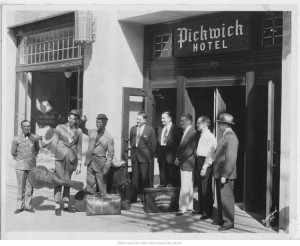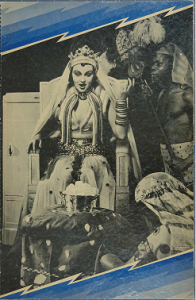In October 2012, the Marr Sound Archives completed an 18-month National Endowment for the Humanities grant to catalog and preserve the nearly 3,000 broadcast recordings in the Arthur B. Church KMBC Radio Collection. Please enjoy this series of anecdotes recounting the unusual discoveries and amusing happenings in the course of working with this collection.
This is the third in a series of Tales from the Archives.
Happy Hollow is a Real Place

Happy Hollow cast and others, including Brookings Montgomery, outside entrance to Pickwick Hotel at the start of troupe’s European and African tour. Credit: Missouri Valley Special Collections, Kansas City Public Library, Kansas City, Missouri.
Rural programming was pretty common in the 1930s and ‘40s, and KMBC had its own in the town of Happy Hollow which gave listeners a peek into the daily lives of Aunt Lucindy, Uncle Ezra, Harry Checkervest, George Washington White (their own blackface character), and other town folk, along with musical interludes by the Humdinger Quartet.The program’s creator, Ted Malone, would have a long and successful career in radio broadcasting, mostly known for his storytelling and poetry reading, and as we later discovered by going through his fan mail, he was very popular with the housewives…in an uncomfortable way.
Listeners engrossed in the goings-on of Happy Hollow could find out more by subscribing to the newsletter Happy Hollow Bugle. We came upon the newsletter when I sent my most enthusiastic student upstairs to Special Collections to see if he could find out more about the program, specifically, what radio actors were cast in the various roles. My instructions were simple: Look over the finding aid and pull whatever seems like it might contain some information about the show. I figured this wouldn’t take long since there didn’t appear to be much in the Church-KMBC Collection finding aid. About ten minutes in, I received a phone call from my very excited student telling me that one of the Special Collections staff pulled a newsletter called Happy Hollow Bugle from the Ted Malone Collection, and that there was all kinds of helpful information in it. Relieved that he had found something useful, I instructed him to gather up the relevant data for identifying the characters in the show.
Over an hour passed by, and just as I was beginning to wonder what was going on, he walked in. I saw him from a distance, all wide-eyed, headed straight toward me clutching a pencil and papers in his left hand, and I thought, “This is it. He’s going to tell me how he hit the jackpot of details on this show, and I might even be able to establish some names in the authority file.” He had spent an hour and a half in the archives, after all. But instead, he approached and exclaimed, “Happy Hollow is a real place!” As I was laughing (hard), he proceeded to tell me about the legal troubles that Uncle Ezra had found himself in, how some of the townsfolk had traveled to Africa, and other documented occurrences that had convinced him of its realness.
Tried and tried as I might to crush his new-found beliefs so suddenly (e.g., “So there’s just a guy in town who likes to walk around in blackface?”), he remained convinced and I remained amused. The good news: we were able to identify some of the actors. In fairness to my student, the cast of Happy Hollow and other KMBC stars did tour Europe and Africa. Kudos to KMBC for blending fiction and reality in their marketing so effortlessly. They had at least one person convinced 80 years later!


